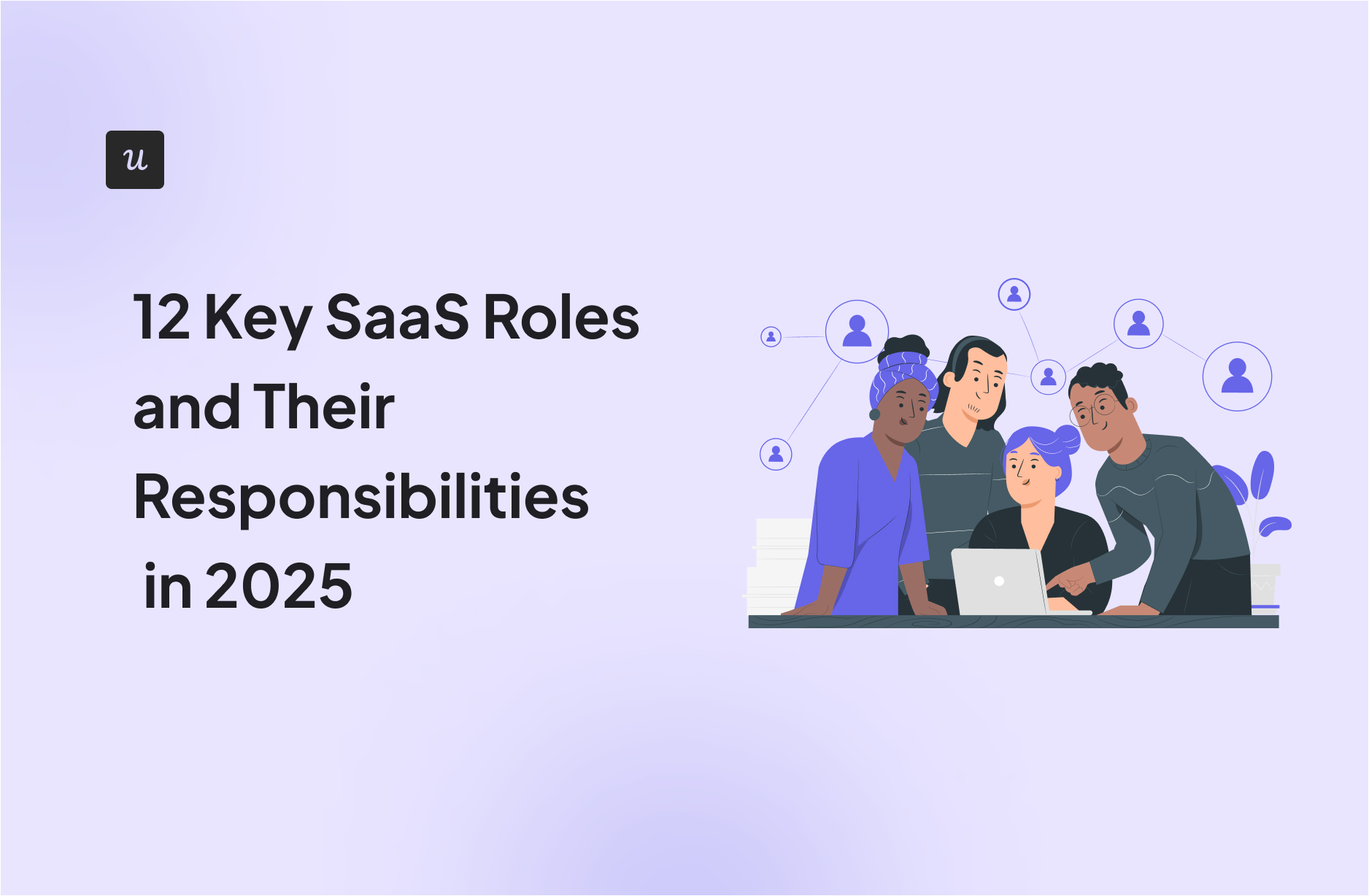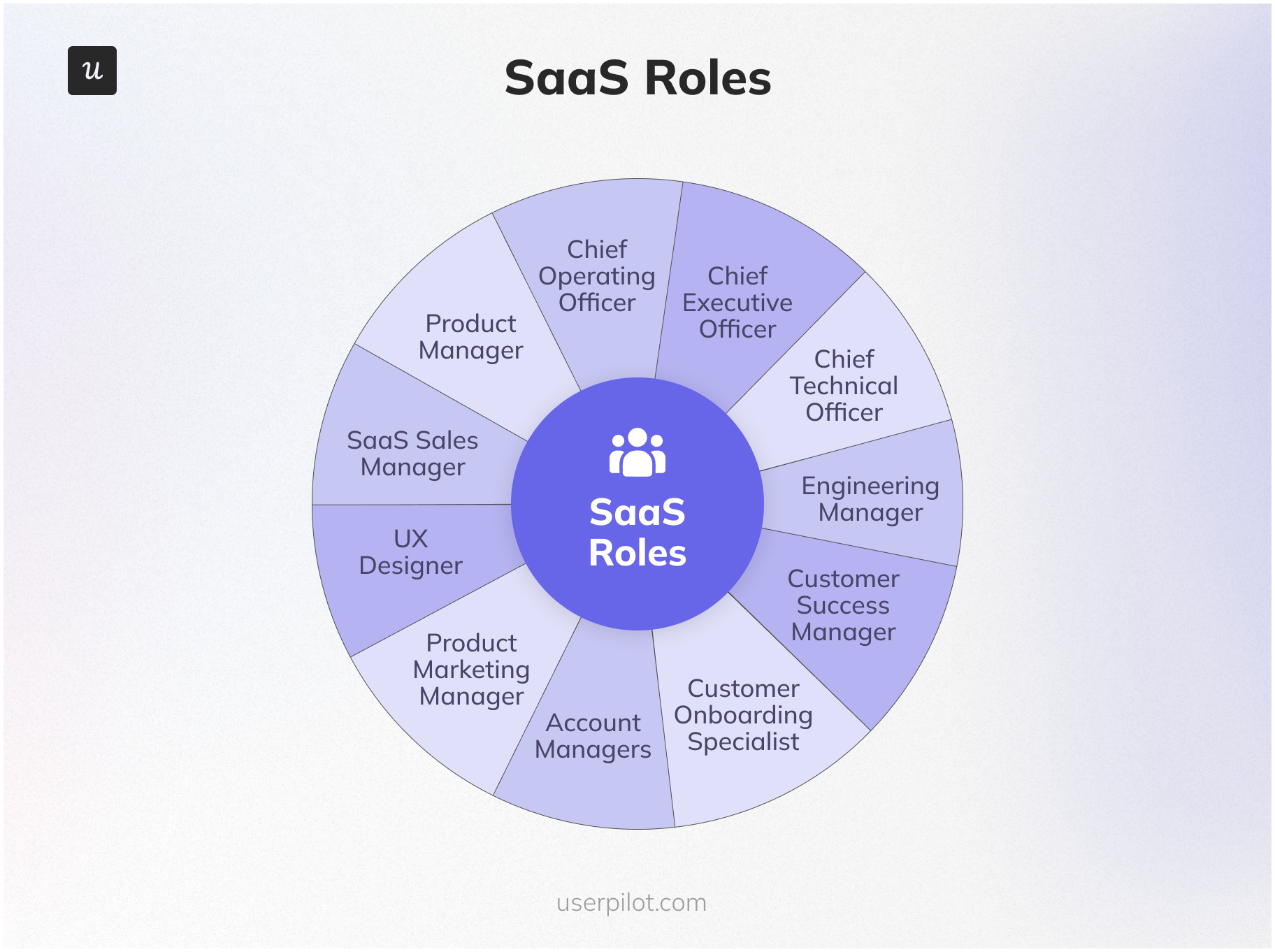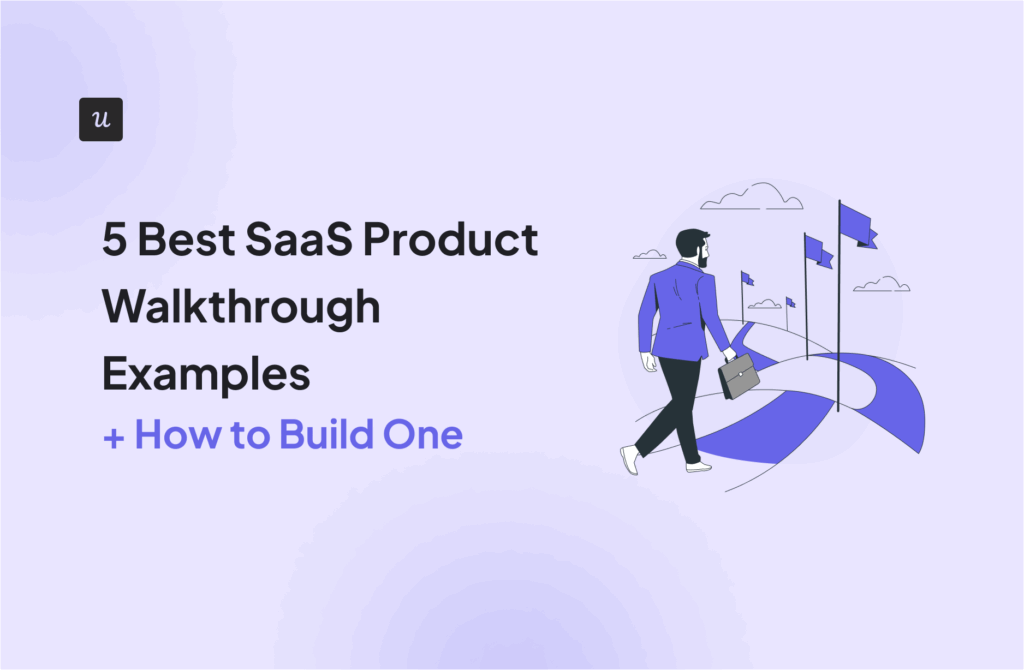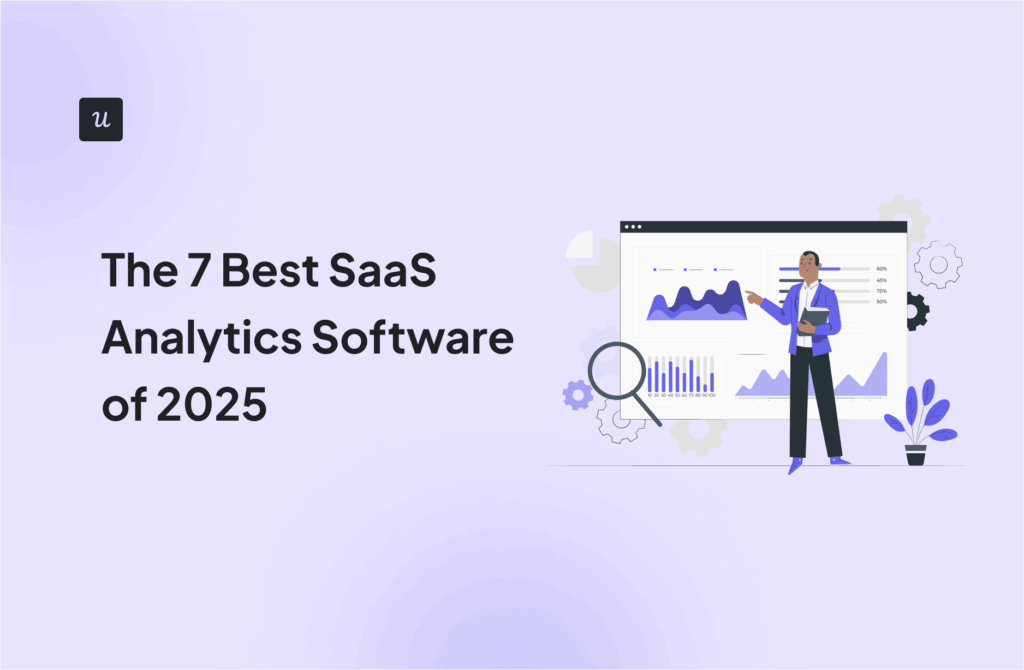
Confused about trying to understand SaaS roles?
That’s perfectly normal. SaaS companies have many moving parts, and it can be difficult to determine who does what.
In this article, we’ve outlined the major roles that move the needle in terms of product growth alongside their KPIs and current salary ranges.
Try Userpilot Now
See Why 1,000+ Teams Choose Userpilot

12 SaaS roles to know
- Chief Executive Officer: As the highest-ranking executive, this person ensures the company runs smoothly and employees are happy and engaged. Average salary: $196,172/yr.
- Chief Technical Officer: Responsible for outlining the company’s technological vision, implementing technology strategies, and ensuring that the technological resources are aligned with the company’s business needs. Average salary: $191,286/yr.
- Chief Operating Officer: Responsible for overseeing day-to-day operations, providing strategic advice, and managing the company’s operations. Average salary: $192,383/yr.
- Engineering Manager: In charge of planning, designing, and overseeing projects. They also manage finances and supervise one or more engineering teams. Average salary: $151,254/yr.
- Product Manager: In charge of creating product strategy and overseeing the design process, among other things. Average salary: $111,208/yr.
- UX Designer: Responsible for understanding the unique needs and requirements of SaaS users and designing the user interface and experience of SaaS products. Average salary: $100,340/yr.
- SaaS Sales Manager: Leads the sales team and is responsible for driving revenue growth by selling the company’s software products.
- Customer Success Manager: This person is responsible for customer satisfaction and building relationships as well as acting as the voice of the customer. In large companies, the CSM also oversees other customer success roles. Average salary: $95,566/yr.
- Customer Onboarding Specialist: Responsible for helping new customers get up and running with the company’s products. Average salary: $46,035/yr.
- Account Managers: They serve as the lead point of contact for all customer account management matters. Average salary: $105,761/yr.
- Product Marketing Manager: This person is tasked with developing product marketing campaigns, crafting compelling marketing messages, and coming up with ideas to retain customers. Average salary: $156,062/yr.
What is a SaaS business model?
SaaS, or “Software as a Service,” is a business model that delivers centrally hosted software to subscribers over the internet. This model contrasts the traditional—and outdated—model where users purchase and install software on their computers or servers.
What to do before building a team for your SaaS company
You can’t just jump into hiring without some forethought, or you’ll make many mistakes.
Before the hiring process, take some time to decide on your current needs and hire as your company grows. For example, a startup might not need a sales manager or a fully-fledged sales team in its early days, but a UX designer is an absolute necessity.
What are the different roles in SaaS companies?
Depending on maturity level, a SaaS company can have hundreds or even thousands of employees. Below are the core roles for a SaaS business in the introductory and growth stages.

Chief Executive Officer
As the highest-ranking executive, the CEO ensures the company runs smoothly and employees are happy and engaged.
The CEO’s key responsibilities include setting goals and objectives for the company and creating an organizational structure that helps the company succeed.
The average CEO salary is $196,172, according to Glassdoor.
KPIs and success metrics to track
- Income statement (P&L) and Balance Sheet: CEOs don’t need to check these documents on a daily basis, but regular analyses keep them in the loop of the company’s financial position. Among other things, the information is useful for streamlining the company’s financial objectives and keeping shareholders/investors happy.
- Cash Position and Flow: These metrics help CEOs track how much money is at hand, what’s coming in, and how the cash is spent. Monitoring cash position and flow is crucial for assessing liquidity and the ability to meet short-term obligations.
- Revenue growth rate: This measures the rate at which the company’s revenue is growing over a specific period. It reflects the effectiveness of the company’s sales and marketing strategies, market demand for its products or services, and the ability to capture market share. A higher revenue growth rate generally indicates positive business performance.
- Employee satisfaction score: Satisfaction and engagement among employees are typically measured through anonymous employee surveys and one-on-one interviews.
Chief Technical Officer
The CTO is responsible for outlining the company’s technological vision, implementing technology strategies, and ensuring that the technological resources are aligned with the company’s business needs.
According to Glassdoor, the average salary is $191,286 per year.
KPIs and success metrics to track
- Mean Time To Recovery (MTTR): MTTR measures the average time it takes to recover from a system outage or failure. A lower MTTR indicates a more efficient incident response and resolution process.
- Number of Platform Downtimes: Your company will be more effective if the SaaS product has low downtimes. Tracking the number of platform downtimes helps identify areas for improvement in system stability, reliability, and infrastructure resilience.
- Time to Market for New Products: Also known as velocity, this metric measures the CTO’s effectiveness and speed in rolling new products/features. Much of the success here depends on how competent and motivated the CTO and their team is.
- Percentage of Projects Delivered on Time and Within Budget: It all boils down to project planning, resource management, and execution. The company needs a high percentage of this metric to stay competitive.
- Technology Adoption Rate: This metric measures the rate at which your organization adopts and integrates new technologies or tools within its infrastructure and processes. Tracking the technology adoption rate helps evaluate your company’s readiness for innovation and its ability to adapt to technological advancements.
Chief operating officer
The COO oversees day-to-day operations, provides strategic advice, drives business decisions, and manages the company’s operations.
The average COO salary, according to Glassdoor, is $192,383 per year.
KPIs and success metrics to track
- Current accounts payable: This metric refers to the amount your company owes creditors—vendors, banks, etc. Tracking your accounts payable helps the COO manage vendor relationships, maintain positive cash flow, and ensure timely payment to support uninterrupted service delivery.
- Operating cash flow: This measures the cash your core operations generate during a specific period.
- Gross profit margin: This is the percentage of revenue that remains after deducting the direct costs associated with delivering your SaaS product, such as support, hosting expenses, data storage costs, and third-party licensing fees.
- Net profit margin: This metric shows how much of your revenue translates to profit. It’s calculated by deducting all expenses, including both direct costs associated with delivering the SaaS product and indirect operating expenses such as sales and marketing, research and development, and administrative costs.
Engineering Manager
The Engineering Manager’s duty is to plan, design, and oversee projects. They also manage finances and supervise one or more engineering teams.
According to Glassdoor, Engineering Managers make an average of $151,254 per year.
KPIs and success metrics to track
- Engineering efficiency: This measures the effectiveness of the engineering team in delivering software projects or features. It can be quantified by factors like lines of code written per developer, number of features implemented per sprint, or time taken to resolve issues.
- Benefit-cost ratio: This financial metric compares the expected benefits of a project or initiative against its costs. It helps evaluate the economic viability and potential ROI of a particular engineering project or initiative. It’s important that the Engineering Manager favors projects with high benefit-cost ratios.
- Net present value: This calculates the present value of future cash flows associated with an engineering project. A positive NPV indicates that the project is expected to generate more financial value than the initial investment. Engineering Managers use NPV to assess the profitability and financial feasibility of long-term engineering projects.
- Avoided cost: This measures the financial benefit from preventing or mitigating potential issues, such as defects, downtime, or rework.
- Cost performance indicator: This is a project management metric that compares the actual cost of completing a project against the planned or budgeted cost. By tracking the CPI, you can identify early warning signs of potential cost overruns and find solutions.
- Code churn: This metric quantifies the amount of code added, modified, or removed, within the first 2-3 weeks of writing. High code churn is normal in the early days of the software development lifecycle, but this should reduce as your release date approaches.
Product Manager
The Product Manager’s role is to:
- Create a product strategy.
- Come up with product and new feature ideas.
- Oversee product design.
- Conduct market research.
- Perform product optimization, road mapping, and backlog prioritization to help customers achieve their objectives.
The average Product Manager makes $111,208 per year, according to Glassdoor.
KPIs and success metrics to track
- Customer lifetime value: This estimates the net profit your company can expect from each customer. It considers subscription fees, additional purchases, upgrades, and renewals.
- Retention rate: This is the percentage of users that continue using your product after a specific period.
- Monthly Recurring Revenue: This metric measures the predictable revenue your company generates monthly from paying users.
- Average Revenue per User: This calculates your company’s average revenue from each user over a given period. It’s derived by dividing the total revenue by the total number of customers.
- Churn rate: Percentage of users that stopped using your product or downgraded their accounts in a given period.
UX Designer
The UX Designer is responsible for understanding the unique needs and requirements of SaaS users and designing the user interface and experience of SaaS products.
UX Designers make an average of $100,340 annually, according to Glassdoor.
KPIs and success metrics to track
- Task success rate: This metric measures the percentage of users who successfully complete specific tasks or goals within the product.
- Time-on-task: Measures the time users spend completing specific tasks or actions within the product. It reflects the efficiency and intuitiveness of the user interface.
- User error rate: This measures how many mistakes a user makes when performing specific tasks.
- Navigation vs. search: Users have two options when finding information on your platform: rely on navigation menus and links or use the search functionality. This metric compares the ratio of users that use navigation vs search.
- System usability scale (SUS): This is an attitudinal UX metric that uses a Likert scale to measure the user’s perceived usability of your product. Tracking SUS scores allows you to identify strengths and weaknesses in the user experience, and guide iterative design improvements.
- User satisfaction: This metric helps you measure whether your product meets or surpasses customer expectations.
SaaS Sales Manager
The SaaS sales manager leads the sales team and is responsible for driving revenue growth by selling the company’s software products. This involves
- developing and implementing sales strategies;
- managing a team of sales representatives (including sales development reps);
- building relationships with potential customers.
KPIs and success metrics to track
- Annual Recurring Revenue (ARR): This measures the predictable revenue generated from subscriptions on an annual basis. It’s a key indicator of the overall health and growth of the SaaS business.
- Customer Acquisition Cost (CAC): This calculates the cost of acquiring a new customer. It’s important to keep CAC as low as possible while maintaining an effective sales process.
- Customer Lifetime Value (CLTV): This estimates the total revenue a customer will generate throughout their relationship with the company. A high CLTV indicates a successful sales and customer retention strategy.
- Lead-to-Opportunity Conversion Rate: This measures the percentage of qualified leads that convert into sales opportunities. It reflects the effectiveness of lead qualification and nurturing efforts.
- Opportunity-to-Win Conversion Rate: This tracks the percentage of sales opportunities that result in closed deals. It indicates the sales team’s ability to effectively present the software’s value and close deals.
- Sales Cycle Length: This measures the time it takes to close a deal from the initial contact with a lead. A shorter sales cycle is generally desirable as it leads to faster revenue generation.
- Average Deal Size: This calculates the average value of closed deals. Increasing the average deal size can significantly impact revenue growth.
Customer Success Manager
The Customer Success Manager supports customers as they transition from sales prospects to active product users. This person is responsible for nurturing customer relationships, acting as the voice of the customer, and building a customer success team when necessary.
Customer Success Managers make an average yearly salary of $95,566, according to Glassdoor.
KPIs and success metrics to track
- CSAT: This uses customer feedback surveys to measure satisfaction with a specific product, feature, or interaction.
- NPS: The Net Promoter Score measures a customer’s sentiment by asking them about the likelihood that they’d recommend you to others.
- Conversion Rate: This tracks the percentage of trial or freemium users who convert into paying customers.
- Customer Health Score: This metric factors product usage, engagement, support interactions, and other relevant data points, to determine how likely users are to stay consistent or churn.
- First Contact Resolution: Measures the percentage of customer inquiries resolved during the initial contact with customer support.
- Customer Effort Score: This metric estimates the perceived effort customers exert to interact with your business. The customer success team should regularly track this metric and improve the user experience.
Customer Onboarding Specialist
An Onboarding Specialist is responsible for:
- Helping new customers get up and running with the company’s products.
- Educating new customers on how to use the product, providing support, and resolving any issues that may arise.
- Conducting onboarding meetings, product tours, company presentations, and product demos.
- Collecting customer feedback to improve.
Per Zip Recruiter, Onboarding Specialists earn an average salary of $46,035 a year.
KPIs and success metrics to track
- Engagement rate: This measures the level of customer interaction with your product, especially during the onboarding process.
- Free trial conversion rate: This metric is the percentage of free trial users that convert to paying customers.
- Onboarding completion rate: This is the percentage of users that complete your onboarding process. High completion rates lead to better product adoption and customer retention.
- Time to value (TTV): This measures how long before customers realize the full value and benefits of your product. Quick TTV leads to increased adoption rates and vice versa.
- Activation rate: The activation rate is the percentage of customers who complete key activation steps or milestones in the onboarding process.
Account Managers
SaaS Account Managers are crucial for nurturing and expanding relationships with existing customers. Their responsibilities include:
- Serve as the lead point of contact for all customer account management matters.
- Build and maintain strong, long-lasting client relationships.
- Negotiate contracts and close agreements to maximize profits.
- Develop trusted advisor relationships with key accounts, customer stakeholders, and executive sponsors.
The average yearly salary is $105,761, according to Glassdoor.
KPIs and success metrics to track
- Organic growth: This is the increase in revenue from existing accounts without relying on new customer acquisition. It shows the Account Manager’s ability to nurture and expand relationships with current customers.
- Customer interaction: This is the quality of interactions between the Account Manager and their customers. It includes activities such as calls, emails, and communication through other channels. High customer interaction is proof of budding customer trust.
- Time to resolution: It’s not enough to interact with users. The Account Manager needs to ensure customer issues are resolved as quickly as possible—preferably during the first interaction.
- Client acquisition rates: This simply refers to the number of new clients acquired within a specific period.
- Customer upsell revenue: The revenue The Account Manager generates for the company by regularly identifying opportunities to expand product offerings and get more users to buy them.
Product Marketing Manager
The Product Marketing Manager is tasked with developing strategies across pricing, advertising (i.e. GTM marketing campaigns), product launch, etc., and their activities contribute to reducing the customer acquisition cost.
Per Glassdoor, PMMs have an average salary of $156,062 per annum.
KPIs and success metrics to track
- Product usage rate: This is the extent to which customers are actively using your product or specific features within it. The metric quantifies both the frequency and depth of engagement.
- New feature adoption rate: How many users are actively using your new features? Tracking this data tells you if customers find the features valuable and whether you’re marketing them enough.
- Customer retention cost: This is the expense incurred to retain existing customers. It includes costs associated with customer support, account management, customer success initiatives, and retention marketing activities.
Conclusion
The roles above are necessary to drive sustainable SaaS growth. If you’re unsure of which to begin hiring, it might help to conduct a skills gap analysis.
After hiring the SaaS roles, it’s also important to have the right tools. SaaS companies like you trust Userpilot to unlock growth at every stage of the customer journey through journey analytics and in-app marketing. Book a demo to see how our platform can help your SaaS team thrive!







